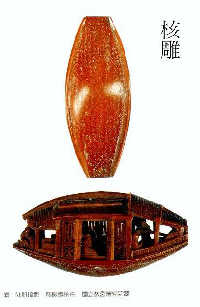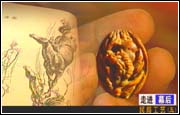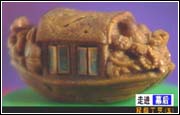Nut carving, known as Hediao in Chinese, generally refers to two kinds of carvings that respectively use fruit stone (also known as the fruit's pit), like olive or peach stone, and walnut as the raw material. The art form is acclaimed for its delicate carving skills on the small fruit stones or walnuts, and is known as an "uncanny work of art" among the people.
Nut carving generally uses relief and three-dimensional carving skills due to the materials' limited surface area. To produce a fine piece of nut carving, one has to make good use of the shape, grains, and texture of the material; a blueprint also has to be made before the actual carving can begin.
Nut carving prospered in the Song Dynasty (960-1279), and by the Ming Dynasty(1368-1644), the art form had already attained very high achievements, with many of the rich and high officials considered it fashionable to wear a piece of nut carving around. Up to the Qing Dynasty(1644-1911), the carving artists upheld the notion of nut carvings requiring more delicate and refined skills.
Ancient traditions

The ancient artists left their consummate skills on those small works, which featured human figures, various utensils, and some even with lines of poems. Such legacies inspired many ancient literati to record them with passages, with one of them known as Nut Carving Boat, which has been included in Chinese middle school textbooks.

Many people came to know the art form beginning from this passage, which describes the nut carving work by Wang Shuyuan in the Ming Dynasty. The work, carved on a peach stone, features the scene of Su Dongpo (an influential poet and essayist of the Song Dynasty) going boating at night in Chibi in Central China's Hubei Province.
The boat is about three centimeters long. The bump in the middle of the peach stone is the little boat's cabin. On each of the cabin's two sides, there are four windowpanes. When the windows are opened, one can see two delicately decorated poles with flower patterns; when the windows are closed, one can see the poems carved on the cabin's two sides. On the boat's bow and stern, there are five figures featured altogether, each of them being vividly carved and with poise.
Peach, pronounced "tao" in Chinese, is homophonic to escape. Thus the word always has an auspicious meaning, and is used to avoid misfortunes and ward off evil. By the early part of the Spring and Autumn Period(770-476BC), the custom of using the peach wood to drive away evil spirits had already been very widespread.

In the Ming and Qing dynasties, nut carving, with a variety of themes, was very popular in South China's Guangdong Provinceand the eastern provinces of Jiangsu, Fujian, and Shandong. One of the most popular themes involves the boat.
Although boat carving required a very high level of carving skills, the theme of Su Dongpo going boating at night had always been very popular since its inception. However, the masterpiece featuring this theme by the aforementioned Wang Shuyuan, no longer exists, leaving its description in middle school textbooks as its only legacy.

Chen Zuzhang, a carving artist from Guangdong Province during the Qing Dynasty, created another work of the same theme with olive stone. Based on the experiences of his forerunners, Chen also had some noticeable breakthroughs artistically. Different from Wang's work, Chen's piece featured seven people altogether, each of which was delicately carved. Chen's work is now collected in the Taipei Imperial Palace Museum.










